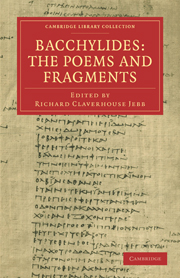Book contents
- Frontmatter
- NOTE
- PREFACE
- Contents
- BIBLIOGRAPHY
- GENERAL INTRODUCTION
- I THE LIFE OF BACCHYLIDES
- II THE PLACE OF BACCHYLIDES IN THE HISTORY OF GREEK LYRIC POETRY
- III CHARACTERISTICS OF BACCHYLIDES AS A POET
- IV DIALECT AND GRAMMAR
- V METRES
- VI THE PAPYRUS
- AUTOTYPE PLATES
- VII THE TEXT OF THE PAPYRUS
- INTRODUCTIONS TO THE ODES
- TEXT, NOTES, AND TRANSLATION
- FRAGMENTS
- APPENDIX
- VOCABULARY
- INDEX
- Plate section
IV - DIALECT AND GRAMMAR
Published online by Cambridge University Press: 03 May 2011
- Frontmatter
- NOTE
- PREFACE
- Contents
- BIBLIOGRAPHY
- GENERAL INTRODUCTION
- I THE LIFE OF BACCHYLIDES
- II THE PLACE OF BACCHYLIDES IN THE HISTORY OF GREEK LYRIC POETRY
- III CHARACTERISTICS OF BACCHYLIDES AS A POET
- IV DIALECT AND GRAMMAR
- V METRES
- VI THE PAPYRUS
- AUTOTYPE PLATES
- VII THE TEXT OF THE PAPYRUS
- INTRODUCTIONS TO THE ODES
- TEXT, NOTES, AND TRANSLATION
- FRAGMENTS
- APPENDIX
- VOCABULARY
- INDEX
- Plate section
Summary
The dialect prescribed by tradition for choral lyric poetry was Doric in its general colouring. But the Doricism could be more or less strongly marked, and more or less tempered by an admixture of non-Doric forms, according to the taste of the poet. Indeed, as Pindar shows, the same poet might vary the complexion of his dialect from ode to ode. In the dialect of Bacchylides, the Doricism,—which for him, an Ionian, was purely conventional,—is of the mildest type. It is further distinctive of him that, in numerous instances, he modifies Doric forms by compromises which his own sense of euphony dictated, but which it is difficult to bring under any consistent rules.
Doric a.
He sometimes retains η, instead of the Doric α, in order to avoid the occurrence of the a-sound in two successive syllables. Thus he writes ἀδμήτα (V. 167), but ἄδματοι (X. 84): λῃσταί (XVII. 8), but λαΐδος (XV. 17): φήμα (II. I), but φαμὶ καὶ φάσω (I. 49). It is not easy to see why he should agree with Pindar in writing προφάτας (VIII. 3, IX. 28), and yet differ from him in writing κυβερνήτας (V. 47, XI. 11). Pindar has ζαλωτός: Bacchylides has ἐπίζηλος (V. 52), πολύζηλος (X. 63), πολυζήλωτος (VII. 10, etc.). His ʾΑθάνα (XII. 195, etc.) and ʾΑθᾶναι (XVII. 60) may be explained by supposing that, in these instances, the Doric convention of the choral lyric was too strong for him.
- Type
- Chapter
- Information
- Bacchylides: The Poems and Fragments , pp. 79 - 92Publisher: Cambridge University PressPrint publication year: 2010First published in: 1905



